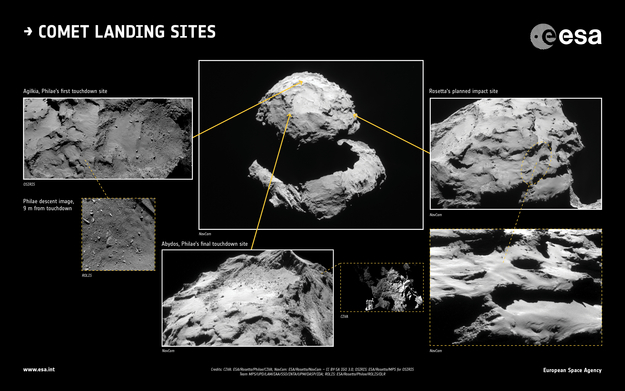
Bern, 27 September 2016 – Rosetta is set to complete its mission in a controlled descent to the surface of the comet 67P/Churyumov-Gerasimenko on 30 September 2016.
The University of Bern, which played an important role namely with on-board instruments such as Rosina, is organising a farewell event on Friday 30 September as of 11:00 to witness and celebrate the final hours and success of this iconic mission, to which a number of Swiss organisatons contributed. (Further information can be found at: www.rosetta-finale.ch)
ESA’s Rosetta spacecraft arrived at Comet 67P/Churyumov–Gerasimenko on 6 August 2014, following a ten-year journey through the Solar System after its launch on 2 March 2004. The Philae lander was sent down to the surface of the comet on 12 November 2014. After two years of living on the comet, returning an unprecedented wealth of scientific information during its closest approach to the Sun, Rosetta and the comet are now heading out beyond the orbit of Jupiter again.
However, Rosetta’s adventure is nearing its end: travelling further from the Sun than ever before, and faced with a significant reduction in the solar power that it needs to operate, Rosetta’s destiny has been set: it will follow Philae down onto the surface of the comet.
On 30 September the confirmation of the end of Rosetta’s mission is expected from ESA’s main control room at 13:20 (Swiss time) +/- 20 minutes, with the spacecraft set on a collision course with the comet the evening before. The final hours of descent will enable Rosetta to make many once-in-a-lifetime measurements, including analysing gas and dust closer to the surface than ever possible before, and taking very high resolution images of the comet’s nucleus, including the open pits of the Ma’at region where the spacecraft is expected to make its controlled impact. This data should be returned during the descent up to the moment of final impact, after which communication with the spacecraft will not be possible.
The mission’s final operations will of course be followed at ESA’s European Space Operations Centre (ESOC) in Darmstadt by members of the large international Rosetta team, including scientists, spacecraft operators, and engineers, as well as representatives from ESA and its partner agencies, along with industry.
Follow online
The briefings on 29 and 30 September 2016 will be livestreamed at: www.esa.int
Live coverage of operational milestones in the final days of the mission will also be provided via the Rosetta blog (blogs.esa.int/rosetta/) and via @ESA_Rosetta (twitter.com/ESA_Rosetta ) and @esaoperations on Twitter (twitter.com/esaoperations). Please use the #CometLanding hashtag on social media.
Original published at: http://spacewatchme.com/2016/09/rosetta-esas-historic-mission-bids-farewell-rendez-vous-comet-chury/
 SpaceWatch.Global An independent perspective on space
SpaceWatch.Global An independent perspective on space

